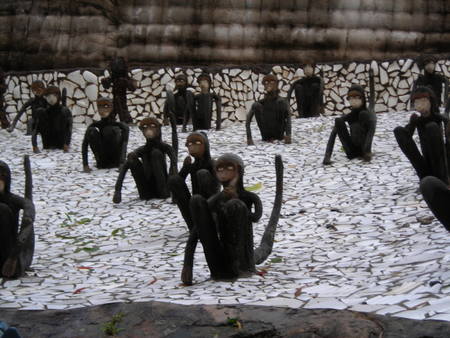Gill Wilson
Residency at Sanskriti Pratishthan
Journey to Chandigarh and Amritsar
Posted by Gill Wilson on 19th February 2007
11th February Rain, Rain, RainIt has rained for two days now - everywhere is flooded, everything changed: it’s dark, cold and damp everywhere. We are hopeful that it will only last for 3 days (that’s what we have been told) before the sun comes out again - the dry ‘pond’ areas are now flooded with water (drained earlier because of outbreaks of Dengi fever). I have been paper casting old woodblocks that I bought yesterday in Haus Kaus Village (small area in South Delhi) in the antique shops. The older textile woodblocks are more abstract in form and could lead to further possibilities.
We are setting off early tomorrow to Chandigarh to see Nek Chands Rock garden and to Amritsar to see the Golden Temple. I am really excited about traveling out of Delhi and seeing the countryside on the way. We are traveling by taxi.
More Rain

Nek Chands Rock Garden in Chandigarh - 12th February
Nek Chand worked under cover of darkness for eighteen years to create his secret place - a clearing in the jungle, stealing away at the end of his working day as a roads inspector. It was there he created the groups of sculpted men and women, imaginary creatures, bears and monkeys. He scavenged discarded urban debris and transported hand picked stones from nearby hills on his bicycle in order to construct the characters that inhabited his realised dream of a kingdom of gods and goddesses. The place is much more surreal than I imagined it would be. (see images)
Amritzar 14th February
Traveled up in torrential rain - lorries stuck at the side of the road in deep water, mud everywhere because the roads are all unfinished the mud soon gets churned up. Amritsar is very busy: the mud gives it a feeling of a city that was once quite rich but now what’s left of it’s interesting architecture seems beyond repair. There are far more rickshaws and bicycles than Delhi. As westerners we seek out more recognisable places to eat - this proves difficult, as several seem to have closed. We find a place called Crystal Palace that has Chinese, Indian and Italian food. Eating is always an extra anxiety when away from Sanskriti and the potential of diarrhea and sickness never far away!
We visited the Golden Temple which is the holiest shrine of the Sikh religion. It was very spiritual: washing feet and covering your head means that you walk around on marble walkways which helps create a sense of calm. We spent time in the two-storey temple, which stands in the middle of the sacred pool. The architecture is a mix of Hindu and Muslim styles. The golden dome is gilded with pure gold. Priests keep up continuous chant in Punjabi from the Sikh’s holy book. We take time here to enjoy the meditative sense of the place, its quite magical.
We also visit Jallianwala Bagh, where 2000 Indians were killed or wounded by the British in 1919. This massacre was a major landmark in India’s struggle for Independence.
In the evening we went to see the closing of the Indian and Pakistan border. It is a ceremony of pure theatre conducted with lots of posturing. The ‘stage’ is divided by two sets of gates, one for each country with the national flag fluttering. A squad from each side parades up and down in front of its audience, stamping its feet, yelling and scowling at the other side. The gates are flung open. The commanding officers march up to each other and perform a short handshake and salute. Bugles blow and the flags are lowered slowly so no flag is higher than the other implying a national superiority. The flag is folded and marched back to the guardroom. The gates are closed and the audience who have been chanting throughout surge onto the road to be photographed.
Sanskriti 16th February
It’s quite strange to be back at Sanskriti - it seems like home in some ways but also being back brings a sense of ‘what next’? It’s important for me to structure time and I wonder if this is a way of hoping time passes quickly. Planning to travel again could seem like willing the time away. This is now the half way point and it increases the pressure slightly - what do I want to achieve before I go home? What do I still want to see in India?
Its good to see the work I produced before we went away and reflect on what I think works and what I want to do next. It’s also good to catch up with what others are doing. The two American artists, Paddy and Rachel, have been gathering large amounts of coloured clays and dried powdered clay for their performance - different areas of the ground are covered then the moisture seeps through and the surface of the clay cracks, ready for their feet to trace the movement of dance. Experiencing different work encourages me to think differently and open up to new approaches and ideas. It has also made me reflect on what is important within a studio group and wonder if the studio group at home could encourage more discussion and collaborative work.
A group of neurosurgeons hires Sanskriti for a performance and dinner. A group of three dancers take the stage and part way through the electricity fails and the dancing has to stop. Sanskriti is ‘dressed’ for the occasion and looks wonderful. The use of flowers to adorn the different area is really magical (see images).

Click on image to open QuickTime movie
"ARTIST'S TALK"
Hanne Rysgaard talks to conference during cHAT week at Sanskriti, Delhi, India. March 2007





